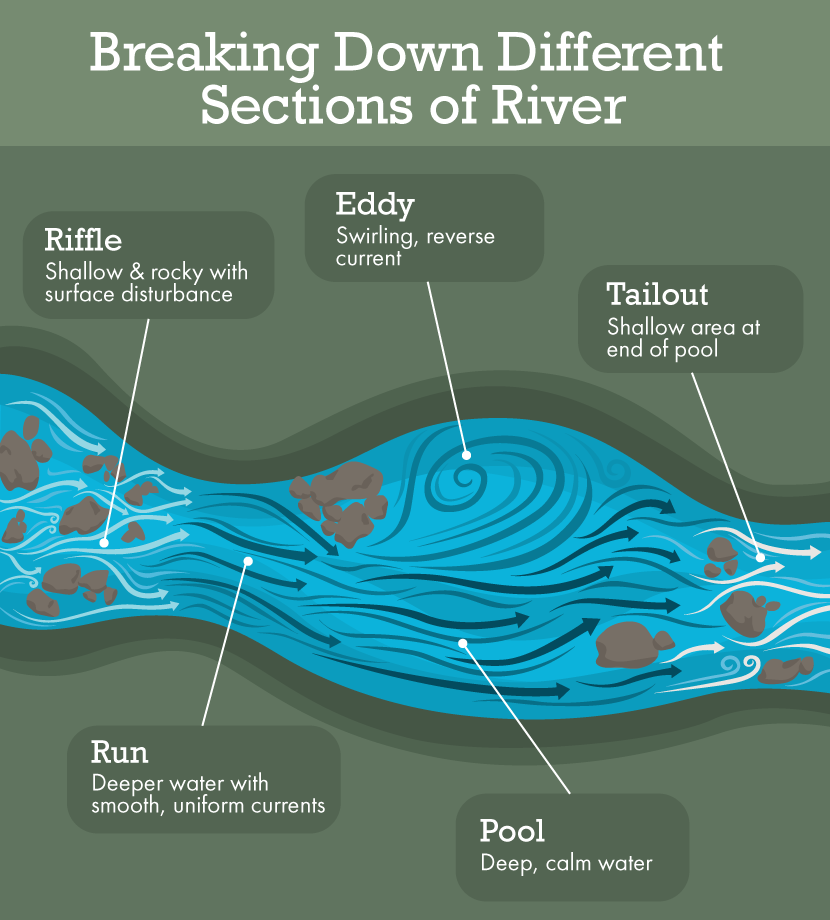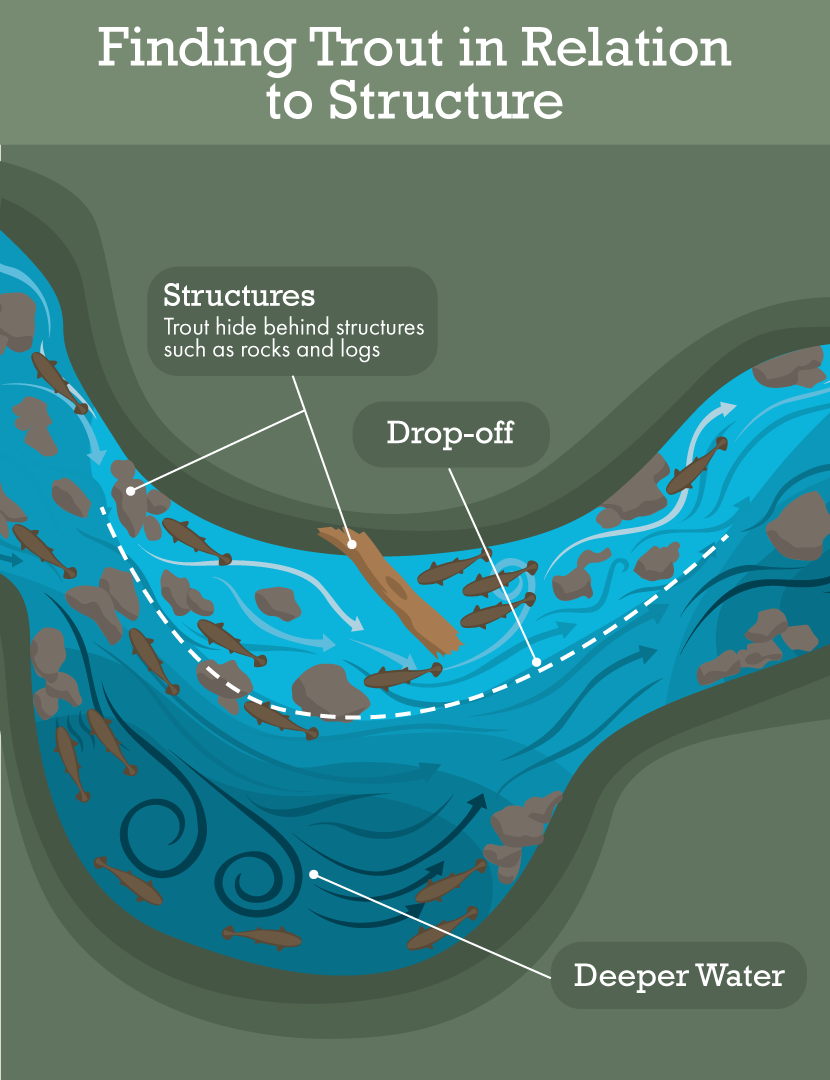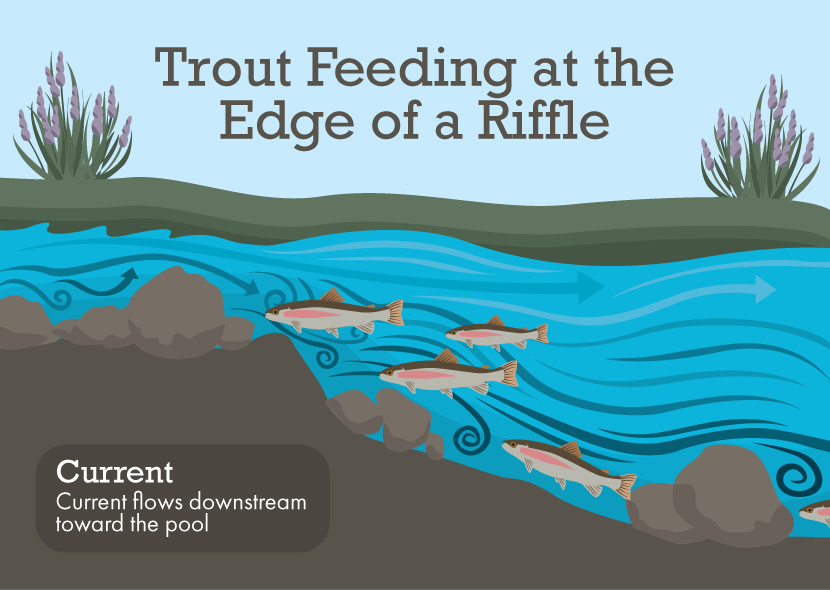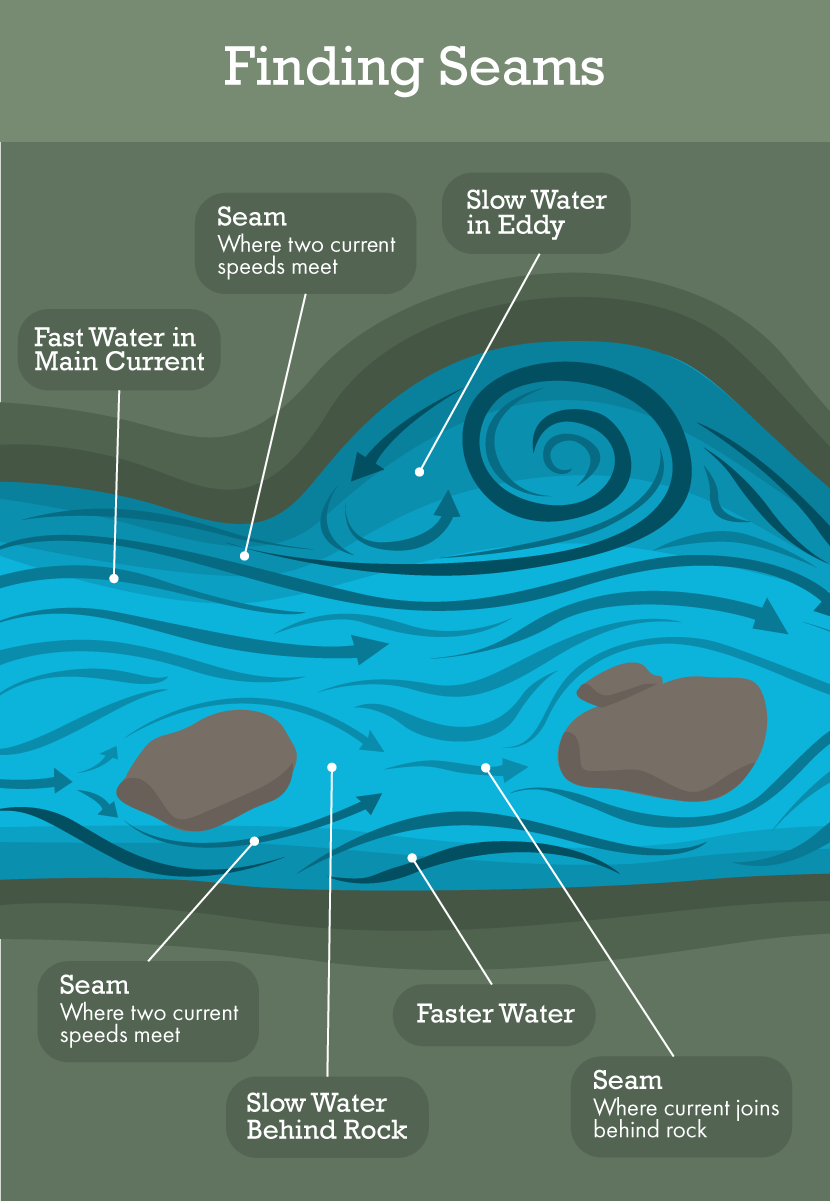Where’s That Trout?(あの鱒はどこに?)
How to Locate Trout in a Stream(川で鱒を見つける方法)
While you might get lucky pulling up to any old spot at a river and throwing a line, learning the areas trout prefer in a stream will increase your chances of catching fish. To understand where to find trout in a river at any given time, it is important to have a basic idea of how trout behave and why they relate to certain areas in the river.
川のどこにでもあるような場所へ行って糸を投げれば、運良く釣れるかもしれないが、鱒の好む場所を知れば、釣れる確率は上がる。ある時期に鱒がどこにいるかを知るためには、鱒がどのように行動し、なぜ川の特定の場所にいるのかという基本的知識を得ることが重要だ。
Oxygen:Trout need to breathe in order to live. In a river you will generally find trout close to current where the water is more oxygenated. Avoid large stretches of stagnant water.
酸素:生きるために鱒は呼吸しなければならない。普通、酸素をよく生成する流れの近くで鱒を見かける。淀んだ流れを避けよ。
Food:Trout need to eat and will seldom stray far from a food source. Find the food and you will find the fish.
エサ:鱒はエサが必要で、めったにエサ場から離れない。エサを探せば、鱒は見つかる。
Shelter and Rest:Trout like to be near current, but they are also quite lazy. They like to find objects to rest behind, and other areas where they can sit outside the main flow. They also need a place to hide from predators. This can be the same structure that blocks the current, or it might be overhead shelter like a tree or bush. Bonus points if the area has quick access to deeper water.
避難と休息:鱒は流れの傍が好きだが、無精者でもある。物陰の休めるところや本流から外れて定位できる場所を見つけたいのだ。また、捕食者から身を隠す場所も必要だ。それは川の流をブロックするものと同じものになるかもしれない。あるいは、木や灌木ような覆い被さった避難場かもしれない。そのエリアが深場へ素早くアクセスできるなら、もってこいの場所だ。
Keeping these elements in mind, you can closely examine the stream environment to find some fish.

When approaching a river for the first time, it is easy to become intimidated by the sheer amount of water. Before making your first cast, you should take a moment to “read” the water. This is the process of examining the stream above and below the surface and breaking it down into manageable sections where fish will likely be. Follow almost any stream as it carves its way through the landscape and you will notice a pattern of characteristics. Learn to identify these patterns and you can use them to help locate trout.
初めて川に接近する場合、その水量に及び腰になりがちだ。最初のキャストをする前に、「流れを読む」ための時間を少し取ろう。これは水面の上と下から川を観察し、扱いやすい区間に、魚がいそうな場所を分解するステップだ。どのような川でも、地形に沿って流れれば、ある一定のパターンがあることに気づくはずだ。このパターンを見分けることができれば、これを鱒がいる場所を特定するために使うことができる。
Sections of a River(流れの区分)
Riffle: A riffle is a rocky, shallow area in a stream where water cascading over rocks creates a noticeable surface disturbance. To identify a riffle, look for a choppy surface or whitewater spilling over shallow rocks into deeper water. A good riffle will fulfill all of the basic needs of a trout. The shallow, highly oxygenated water is a perfect environment for the aquatic insects trout eat. Boulders and rocks create plentiful hiding and resting spots. Deeper water downstream gives trout rest and security. All of these aspects make a riffle a great starting point when looking for trout.
早瀬:Riffleとは、ゴロゴロした川底の浅場で、石の上を水が勢いよく流れるので、水面に顕著な乱流が見られる。瀬を見つけるには、波立つ水面か、浅瀬の岩場から深場になる白波を探せ。良い瀬は鱒が必要とするすべての物がある。浅くて酸素濃度が高い水域は鱒たちのエサとなる水生昆虫にとって最適な環境である。大きな石や岩はたくさんの隠れ家と休息場を作っている。下流の深場は鱒たちに休息と安全な場所を提供する。これらの特徴は「瀬」が鱒を見つけるためのすばらしい出発点なのだ。
Run:A run is an in-between zone directly below a riffle, where the water becomes deeper and the current is more uniform. Aside from a riffle, a run is one of the top places to look for trout in a stream. Trout like the shelter provided by deeper water and the proximity to an easy meal. Fish often suspend at the edge of the current or lie along the bottom eating insects that are carried downstream out of a riffle.
深瀬(平瀬):RunはRiffleの直ぐ下流にある中間エリアのことで、水深は深くなり、流れはより均一になる。瀬とは別に、Runは渓流で鱒を見つけるためのトップクラスの場所だ。鱒は水深がありエサ場に近いの避難場が好きである。魚はときどき水流の縁でサスペンドしたり、川底に横たわって、瀬から下流に運ばれてくる昆虫を食べていることが多い。
Pool: A pool is the deepest portion of any given section of river with the slowest current. Fish will often retreat to a pool on bright, sunny days or if they feel threatened. In shallow streams, pools might be the only areas that hold fish, but it is different for larger rivers. While most river trout – especially big ones – may spend a portion of their day in a pool, typically this is when they are least active.
淵:プールとはゆっくりとした流れで、その区間で最も深場の場所である。魚は脅威を感じたときや天気が良い日はしばしば「淵」に逃げ込む。浅い川では、淵は魚が定位できるただ1つの場所だが大河では状況は異なる。川の鱒、特に大型魚は一日の大半を淵で過ごしている。彼らが活性でない場合、それが典型的だ。
Eddy: An eddy is an area of the river where structure such as an indent in the riverbank, a log, or a large boulder blocks the current flow and influences its direction. Directly downstream of the object, a pocket of swirling water will form opposite the main direction of current flow. Trout love eddies because they funnel and trap insects drifting by in the current. Look for foam or bubbles collecting on the surface where the main current meets up with the swirling water and place your casts there.
渦:Eddyとは川岸の岸壁のくぼみのような地形、または水流をブロックしたり流れに影響を与える長く大きな石のある地形で生じる。障害物の直ぐ下流、渦巻き水流のポケットは水流の流れと逆のの流れを作る。そこは水流によって流れてくる虫たちを集め閉じ込めるので、鱒は渦が好きである。主流と渦巻く水域が合流する場所の泡を探し、そこへキャストせよ。
Tailout:A tailout is a shallow, flat section at the end of a pool before the water spills over into another riffle. Where the water becomes shallow, a natural funnel is formed that brings anything drifting downstream right to the fish. Trout will often wait in a tailout and sip hatching insects off the surface as they float by, so it is a good spot to look for rising fish.
瀬尻:テールアウトとは水域が次の瀬(Riffle)に流れ出す直前のプールの終わりで、浅く平らな区間です。水深は浅くなり、自然の漏斗地形で、魚へ真っ直ぐになんでも運んでくるように形成されている。鱒はしばしば瀬尻で待っていて、水面近くに上がってきた羽化した昆虫を啜る(sip)。だからライズする魚を探すためにはそこはよい場所である。
Examining the Structure
Learning to pinpoint structure in different sections of a river is the final step to reading water like a pro and increasing your likelihood of finding trout. Structure can refer to objects in and around the river such as boulders, gravel bars, holes, and changes in bottom contour. Less obvious examples are eddies and current seams created by the river flow, or shade from a high bank. A good section of river might contain several of these features, and as a rule, areas where different types of structures intersect are prime locations to look for trout.
地形(構造)を調べる
川の様々な区間で川底の正確な構造を知ることは、プロのように川を読み、鱒を見つける能力を高めるための最終ステップである。構造物(Structure)とは大石、砂利の州、窪地、そして、川底の高低変化のような川底やその周辺にある対象のことである。不明確な例は、渦と水流や高い川岸の影によってできる境界だ。川の適当な区間はこれらの特徴のいくつかがある。普通、様々な構造物が混在するエリアは鱒を探すための一級の場所だ。

Boulders, logs, and other obstructions:Any object that impedes the current flow is worth investigating. It’s worth bonus points if it is located in a favorable section of the river such as a riffle, run, or tailout. Multiple casts placed upstream, to the side, and downstream of the object will give you a shot at any fish that may be sitting there.
大石、丸木、他の障害物:川の流れを邪魔するいかなる物も、調べるに値する。それがRiffle, Run, Tailoutのような川の好ましい区間にあるならボーナスポイントに値する。その上流、側面、下流へたくさんキャストすれば、そこにいる魚の一撃になるだろう。
Changes in the river:Bends, gravel bars, shelves, holes, and other changes in the river or bottom contour are great places to look for trout. A good example is the area right where a riffle drops into deeper water. Trout will often rest in the slower current below the drop-off, eating insects that are swept over the edge.
川の変化:川の曲がり、砂利の州、隠れ場所、穴場、その他の変化、川底のデコボコは鱒を見つけるのにもってこいの場所だ。

Other good locations are the insides of river bends, points jutting into the current, and indentations along the bank. A good pair of polarized sunglasses can help locate structure hidden below the surface. Dark areas often signify deeper holes. Look for gravel bars mid-river, and drop-offs or shelves at the river’s edge where the current begins to slow. Fish will be resting and feeding on the deeper side of these areas.
他のいい場所は川の曲がりの内側、流れから張り出したところ、川岸のへっこんだ場所だ。偏光サングラスは水面下の隠れた地形を知るために役に立つ。暗いエリアはときどき水深のある場所を意味する。中流域の砂利州と川の流れが緩やかになり始める川の縁の棚か落ち込みを探せ。魚はそれらの深場で休み採餌しているだろう。
Seams
A “seam” is any spot where two currents converge. Trout like seams because the joining currents create feeding lanes that collect drifting food, so when looking at any structure in a river it is important to locate any associated seams. With some experience you will be able to detect seams as subtle lines along the surface where slower current meets with fast. Watch the current carefully as it flows over and around structure. Look for bubble trails floating downstream or any area where there is a noticeable difference in current speed.
潮目(Seams)は2つの流れが交わる場所だ。流れが合流すると、流れてくるエサが集まり、エサの筋を形成するので、鱒は潮目が好きだ。だから川で構造物を見るとき、関係しそうな潮目を見つけることが重要だ。経験を積むと、ゆっくりした流れが速い流れと合流する場所では、水面に沿って微かな線上の潮目を識別できるようになる。川の流れを注意深く見ろ。下流へ流れていく泡の痕跡と水流と違った速さの場所を探せ。

Next time you head to the river, spend a few minutes reading the water before making a cast. Pick out a section and decide which structure you are going to target. Of course, experience is the key to success, so get out as much as possible and practice these tips. When you do catch a fish try to remember the key features of the area you were fishing. Eventually it will seem like less of an exercise, and reading the water will become an intuitive skill that will lead you to more fish.
次回、川へ行ったとき、キャストする前に川の流れを読むことに数分時間を使え。1つの区間を選び、ターゲットにすべき地形を決めよ。無論、経験が成功の鍵だ。できるだけ出かけて行って、これらの知見を実践せよ。釣れたときは、その釣り場の主要な特徴を記憶するようにしよう。最後には練習しなくてよくなり、流れを読むことはたくさん釣れるようになる直感的な技術となるだろう。

0 件のコメント:
コメントを投稿